
Por lapso deste escriba, a crítica desta nova Carmen do Met (dirigida por David Eyre) escapara ao olho vivo e desperto deste blog. Além de tudo, como bem saberá o avisado leitor, por estas bandas, o enterro de uma produção do insuportável Zeffirelli é motivo de celebração e regozijo!
Sendo certo que os lapsos constituem, para os psicanalistas – categoria onde me inscrevo e revejo –, material privilegiado de acesso ao inconsciente (juntamente com sonhos e sintomas - conjunto a que Freud chamou Retorno do recalcado), a escapadela deu-me que pensar: já antes, (a excitação em mim causada por) uma outra mulher esbelta e encantadora desencadeara, na minha pessoa, movimentos defensivos assaz impressionantes...
Está mais que visto que o dito lapso decorreu de uma excitação vivida como perigosa pela mente de um homem comprometido. Adiante!


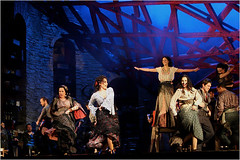

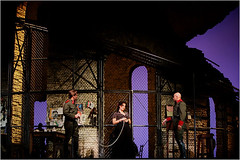
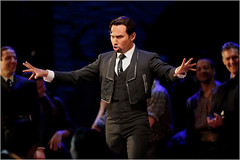

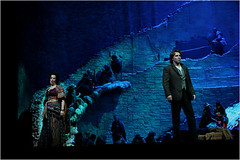
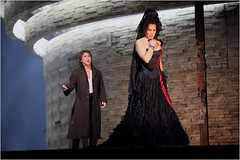
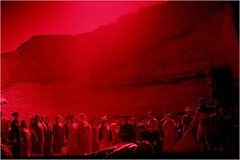
A nova Carmen que o Met estreou esteve, desde a primeira hora, envolta em polémica: concebida para a Dracoulette Gheorghiu, acabou por ser interpretada pela mezzo Garanca. Gheorghiu recusou – ao que parece – contracenar com Alagna, seu ex-marido. Enfim, coisas mundanas.
Pois bem, Elina Garanca acedeu ao chamamento e interpretou uma das mais inflamadas e excitantes personagens da lírica. Gheorghiu voltará à Carmen, para duas récitas apenas, ladeada por Kaufmann. Lá terá as suas razões...
Sendo certo que os lapsos constituem, para os psicanalistas – categoria onde me inscrevo e revejo –, material privilegiado de acesso ao inconsciente (juntamente com sonhos e sintomas - conjunto a que Freud chamou Retorno do recalcado), a escapadela deu-me que pensar: já antes, (a excitação em mim causada por) uma outra mulher esbelta e encantadora desencadeara, na minha pessoa, movimentos defensivos assaz impressionantes...
Está mais que visto que o dito lapso decorreu de uma excitação vivida como perigosa pela mente de um homem comprometido. Adiante!










A nova Carmen que o Met estreou esteve, desde a primeira hora, envolta em polémica: concebida para a Dracoulette Gheorghiu, acabou por ser interpretada pela mezzo Garanca. Gheorghiu recusou – ao que parece – contracenar com Alagna, seu ex-marido. Enfim, coisas mundanas.
Pois bem, Elina Garanca acedeu ao chamamento e interpretou uma das mais inflamadas e excitantes personagens da lírica. Gheorghiu voltará à Carmen, para duas récitas apenas, ladeada por Kaufmann. Lá terá as suas razões...
«That is easy to say, but Mr. Eyre, in his Met debut, has actually done it. With this gripping new “Carmen,” the company rang out 2009 on Thursday evening with a solid success, replacing Franco Zeffirelli’s clueless and clunky production of 1996. Other than updating the Seville setting of the opera to the 1930s from the 1830s, to invoke the brutally repressive period of the Spanish Civil War, Mr. Eyre has created an essentially traditional “Carmen.” Yet, by flushing out details that show the characters bucking against civic and sexual constraints, he uncovers the rawness and daring at the opera’s core.
In the naturalness of the performances, from that of the Latvian mezzo-soprano Elina Garanca in the title role to those of the children in the chorus who scamper into the town square to watch the changing of the guard, it is clear that Mr. Eyre has lavished attention on everyone. The singers benefited immensely from the work of the rising 34-year-old Canadian conductor Yannick Nézet-Séguin, in his Met debut, who led a bracing, fleet and fresh account of the score, although he started the rousing prelude at a breakneck, frenetic tempo.
The production’s success is something of a surprise because the advance buzz had not been encouraging. The Met conceived this as a vehicle for the soprano Angela Gheorghiu, singing the mezzo-soprano title role for the first time, and her husband, the tenor Roberto Alagna, an experienced Don José. But in August Ms. Gheorghiu withdrew from the first six of eight scheduled performances, citing “personal reasons,” which were later revealed to be marital troubles. (She and Mr. Alagna are in the process of divorce.) So the Met brought in Ms. Garanca, best known for her vocally lustrous and agile performances of Rossini. The production provides an ideal context for Ms. Garanca’s nuanced, sexy and cagey portrayal.
The sets and costumes by Rob Howell, in his Met debut, are crucial to the dramatic impact of Mr. Eyre’s concept. During the orchestral prelude, an ominous gray brick wall, sliced through with a blood-red slash, separates to reveal the circular arena that becomes the central scenic element of the staging. The arena’s earthen walls are crumbling in places. Rotating on a turntable, the set suggests, successively, a town square; the tavern where the Gypsies mingle with soldiers; the smugglers’ hideout in the mountains; and the area outside the bullring.
In the opening scene Mr. Eyre uses the set effectively to depict the tensions between the townspeople and the menacing soldiers. A chain-link fence surrounds the arena. On the outside, we see the soldiers in their barracks: bored, playing card games, shaving, reading newspapers. Inside, through the fence, we see the gathering crowd. When the set rotates, the square is revealed, and people stream in. We first see Mr. Alagna’s Don José, an obedient corporal, marching in step with the other solders.
The female choristers who play the Gypsies in a cigarette factory look poignantly real when they first appear (from an underground work area), wearing beige dresses and dusty factory aprons. Only Carmen wears a lacy black dress under her apron. And during the Habanera, when Carmen decides to ensnare the shy and attractive Don José, instead of prancing about the stage doing the typical Carmen dance, Ms. Garanca rinses out her sweaty apron in an open basin in the square, then coyly washes her bare legs.
Ms. Garanca does not have the sort of big, smoldering voice that many opera buffs want in a Carmen. But she sings with rich sound, an unerring feel for the nuance and subtext of a phrase, and alluring sensuality. The clarity in her singing makes this Carmen seem intelligent and wily. A lovely blonde, Ms. Garanca, 33, is captivating in her curly black wig.
Whether Mr. Alagna has made the most of his abundant vocal gifts during his career is a constant topic of discussion in opera circles. And struggling with a cold, he had to skip the final act of the dress rehearsal on Monday. On Thursday he sounded congested at times.
Yet Don José remains one of his strongest roles. The grainy texture of his sound mingles well with the nasal colors of the French language. He sings with an involving blend of intensity and refinement. To his credit, even when under the weather, he tried to sing the climactic B flat in the “Flower Song” pianissimo, as written, something few tenors do. He cracked a little but nearly pulled it off. And he gives himself over to this complex role, conveying the pitiable anguish of the weak-willed Don José, who is overcome with desire for Carmen yet disgusted with himself for abandoning his responsibilities, both to his regiment and to his forgiving mother back home.
The soprano Barbara Frittoli is wonderful as the good-hearted and constant Micaëla, an emissary from Don José’s mother. Her vibrato is sometimes overly throbbing, but the Italianate richness of her voice makes her Micaëla seem a young woman of courage and determination. And she appears achingly vulnerable with her sensible wool coat and brown satchel.
The baritone Mariusz Kwiecien absolutely looks the part of the dashing, cocky toreador Escamillo, a role that straddles the bass-baritone divide. After an uneven “Toreador Song,” music that takes him to the weaker, lower register of his voice, he sang with robust sound and panache. The bass Keith Miller was a standout as the wily officer Zuniga.
The choreographer Christopher Wheeldon has created fetching dances for this production, especially in the tavern scene, in which the Gypsies for once refrain from generic, exotic twirling and do some nifty, rhythmically intricate tapped steps.
But this is Mr. Eyre’s triumph. In only his third opera, he knew what he wanted. I have never seen the final scene, in which the crazed Don José stabs the fatalistically defiant Carmen, executed with such stunning realism, a dangerous mingling of sex, rebellion and violence: the very essence of “Carmen.”»
In the naturalness of the performances, from that of the Latvian mezzo-soprano Elina Garanca in the title role to those of the children in the chorus who scamper into the town square to watch the changing of the guard, it is clear that Mr. Eyre has lavished attention on everyone. The singers benefited immensely from the work of the rising 34-year-old Canadian conductor Yannick Nézet-Séguin, in his Met debut, who led a bracing, fleet and fresh account of the score, although he started the rousing prelude at a breakneck, frenetic tempo.
The production’s success is something of a surprise because the advance buzz had not been encouraging. The Met conceived this as a vehicle for the soprano Angela Gheorghiu, singing the mezzo-soprano title role for the first time, and her husband, the tenor Roberto Alagna, an experienced Don José. But in August Ms. Gheorghiu withdrew from the first six of eight scheduled performances, citing “personal reasons,” which were later revealed to be marital troubles. (She and Mr. Alagna are in the process of divorce.) So the Met brought in Ms. Garanca, best known for her vocally lustrous and agile performances of Rossini. The production provides an ideal context for Ms. Garanca’s nuanced, sexy and cagey portrayal.
The sets and costumes by Rob Howell, in his Met debut, are crucial to the dramatic impact of Mr. Eyre’s concept. During the orchestral prelude, an ominous gray brick wall, sliced through with a blood-red slash, separates to reveal the circular arena that becomes the central scenic element of the staging. The arena’s earthen walls are crumbling in places. Rotating on a turntable, the set suggests, successively, a town square; the tavern where the Gypsies mingle with soldiers; the smugglers’ hideout in the mountains; and the area outside the bullring.
In the opening scene Mr. Eyre uses the set effectively to depict the tensions between the townspeople and the menacing soldiers. A chain-link fence surrounds the arena. On the outside, we see the soldiers in their barracks: bored, playing card games, shaving, reading newspapers. Inside, through the fence, we see the gathering crowd. When the set rotates, the square is revealed, and people stream in. We first see Mr. Alagna’s Don José, an obedient corporal, marching in step with the other solders.
The female choristers who play the Gypsies in a cigarette factory look poignantly real when they first appear (from an underground work area), wearing beige dresses and dusty factory aprons. Only Carmen wears a lacy black dress under her apron. And during the Habanera, when Carmen decides to ensnare the shy and attractive Don José, instead of prancing about the stage doing the typical Carmen dance, Ms. Garanca rinses out her sweaty apron in an open basin in the square, then coyly washes her bare legs.
Ms. Garanca does not have the sort of big, smoldering voice that many opera buffs want in a Carmen. But she sings with rich sound, an unerring feel for the nuance and subtext of a phrase, and alluring sensuality. The clarity in her singing makes this Carmen seem intelligent and wily. A lovely blonde, Ms. Garanca, 33, is captivating in her curly black wig.
Whether Mr. Alagna has made the most of his abundant vocal gifts during his career is a constant topic of discussion in opera circles. And struggling with a cold, he had to skip the final act of the dress rehearsal on Monday. On Thursday he sounded congested at times.
Yet Don José remains one of his strongest roles. The grainy texture of his sound mingles well with the nasal colors of the French language. He sings with an involving blend of intensity and refinement. To his credit, even when under the weather, he tried to sing the climactic B flat in the “Flower Song” pianissimo, as written, something few tenors do. He cracked a little but nearly pulled it off. And he gives himself over to this complex role, conveying the pitiable anguish of the weak-willed Don José, who is overcome with desire for Carmen yet disgusted with himself for abandoning his responsibilities, both to his regiment and to his forgiving mother back home.
The soprano Barbara Frittoli is wonderful as the good-hearted and constant Micaëla, an emissary from Don José’s mother. Her vibrato is sometimes overly throbbing, but the Italianate richness of her voice makes her Micaëla seem a young woman of courage and determination. And she appears achingly vulnerable with her sensible wool coat and brown satchel.
The baritone Mariusz Kwiecien absolutely looks the part of the dashing, cocky toreador Escamillo, a role that straddles the bass-baritone divide. After an uneven “Toreador Song,” music that takes him to the weaker, lower register of his voice, he sang with robust sound and panache. The bass Keith Miller was a standout as the wily officer Zuniga.
The choreographer Christopher Wheeldon has created fetching dances for this production, especially in the tavern scene, in which the Gypsies for once refrain from generic, exotic twirling and do some nifty, rhythmically intricate tapped steps.
But this is Mr. Eyre’s triumph. In only his third opera, he knew what he wanted. I have never seen the final scene, in which the crazed Don José stabs the fatalistically defiant Carmen, executed with such stunning realism, a dangerous mingling of sex, rebellion and violence: the very essence of “Carmen.”»
3 comentários:
a meu ver, garanca teve uma interpretação excepcional. concedeu ao papel de Carmen um toque de sensualidade aveludada capaz de fazer um arrepio na nuca a muitos senhores sem no entanto parecer uma tarada sexual. com uma elasticidade vocal larga para uma mezzo-soprano, creio que conseguiu cantar na perfeição um papel por muitos acarinhado. Sinceramente gostei muito. E também gostei da direcção da orquestra. Não gostei tanto do Alagna, e não gostei nada do interprete que fez de Escamillo.
Caro blogger,
vocalmente, considerei o desempenho de Garanca irrepreensível. Voz redonda, bem timbrada, homogénea em todos os registos. Um verdadeiro bálsamo para os sentidos. Dramaticamente, achei-a um pouco "détaché". Não duvido que em palco exiba bons dotes interpretativos. Todavia, julgo que beneficiaria em estender essa capacidade ao seu instrumento. Há que representar mais com a voz. Yannick Nézet-Séguin ofereceu-nos uma belíssima leitura da obra, estilisticamente correcta. Alagna esteve muito bem, dramaticamente envolvido, não obstante um certo vibrato intrusivo, característico de uma voz já não tão coesa. Frittoli assumiu o papel de Micaela a contento, apesar de começar a soar um pouco pesada para a personagem. Substituindo Mariusz Kwiecien, o neozelandês Teddy Tahu Rhodes exibiu um instrumento pouco brilhante de baixo-barítono, com médios potentes e escuros mas com agudos curtos e algo forçados.
Se me permitem,gostaria de fazer hoje,dia 27,uma homenagem a St.Petersburg,antiga Leningrado,cidade da minha paixão,pois hoje comemora-se o dia do fim do cerco trágico feito pelos alemães e que só terminou em 1944,tendo durado 900 dias,com números catastróficos,de cerca 300 mortos por dia,devido ao gelido inverno russo,á fome e doenças.No final mais de 1 milhão de mortos foram civis e militares mais de 300 mil.É muita coisa.
não sei se é possível aqui deixar um link para um vídeo,vou tentar,as imagens falam por si.
http://www.youtube.com/watch?v=J4OV4OzqrRQ
Enviar um comentário